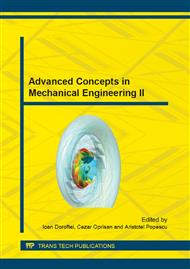p.151
p.157
p.163
p.171
p.177
p.183
p.189
p.195
p.201
Human Head-Neck System Behavior during Virtual Impact Automotive Simulations
Abstract:
The paper presents the studies made on a similar biomechanical system composed by neck, head and dummy body components. The models were defined in a CAD environment which includes Adams algorithm for dynamic simulations. After simulation was obtained the entire mechanical behavior based on data tables or diagrams. That virtual model composed by neck and head was included in complex system (as a car system) and supposed to impact simulations (virtual crash tests). This paper presents issues concerning the use of CAD systems in modern technology virtual prototyping, in this case a complex virtual model for a car system used for impact simulations. Virtual prototyping is a process that uses a virtual prototype instead of the physical prototype for testing and evaluating specific elements of the designed product. Virtual prototype is created on the computer closer to the actual characteristics and operating conditions so as to allow the simulation to perform the role for which it was designed. The three-dimensional model has been exported into simulation software able to perform kinematics simulations and finite element analysis, at the same time. With that virtual model were analysed different situations similar with car crash. Results of simulations have been analysed and can be compared with measurements made on the experimental device (under construction).
Info:
Periodical:
Pages:
177-182
Citation:
Online since:
October 2014
Price:
Сopyright:
© 2014 Trans Tech Publications Ltd. All Rights Reserved
Share:
Citation:


